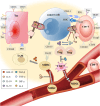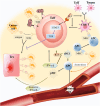CD8+ T cell exhaustion and its regulatory mechanisms in the tumor microenvironment: key to the success of immunotherapy
- PMID: 39372416
- PMCID: PMC11452849
- DOI: 10.3389/fimmu.2024.1476904
CD8+ T cell exhaustion and its regulatory mechanisms in the tumor microenvironment: key to the success of immunotherapy
Abstract
A steady dysfunctional state caused by chronic antigen stimulation in the tumor microenvironment (TME) is known as CD8+ T cell exhaustion. Exhausted-like CD8+ T cells (CD8+ Tex) displayed decreased effector and proliferative capabilities, elevated co-inhibitory receptor generation, decreased cytotoxicity, and changes in metabolism and transcription. TME induces T cell exhaustion through long-term antigen stimulation, upregulation of immune checkpoints, recruitment of immunosuppressive cells, and secretion of immunosuppressive cytokines. CD8+ Tex may be both the reflection of cancer progression and the reason for poor cancer control. The successful outcome of the current cancer immunotherapies, which include immune checkpoint blockade and adoptive cell treatment, depends on CD8+ Tex. In this review, we are interested in the intercellular signaling network of immune cells interacting with CD8+ Tex. These findings provide a unique and detailed perspective, which is helpful in changing this completely unpopular state of hypofunction and intensifying the effect of immunotherapy.
Keywords: CD8 + T cell; T cell exhaustion; adoptive T cell treatment; immune checkpoint blockade; tumor microenvironment.
Copyright © 2024 Zhang, Liu, Mo, Zhang, Huang and Shang.
Conflict of interest statement
The authors declare that the research was conducted in the absence of any commercial or financial relationships that could be construed as a potential conflict of interest.
Figures


References
-
- Beltra JC, Manne S, Abdel-Hakeem MS, Kurachi M, Giles JR, Chen Z, et al. . Developmental relationships of four exhausted Cd8(+) T cell subsets reveals underlying transcriptional and epigenetic landscape control mechanisms. Immunity. (2020) 52:825–41.e8. doi: 10.1016/j.immuni.2020.04.014 - DOI - PMC - PubMed
Publication types
MeSH terms
Substances
LinkOut - more resources
Full Text Sources
Medical
Research Materials

